Glutes can be a problem, whether you go to the gym regularly or not, sometimes our muscles don’t activate and work the way they should…
Or maybe you have an injury/nagging pain, and you need some extra attention. Rather than being bedridden or continuing with the same routine that made you feel this way.
Try taking a step in the right direction to getting back to feeling like your normal self by performing specific exercises to help you get there faster.
Glutes: Rehab Exercises
The first step is figuring out what exactly is causing the pain.
This can be a challenge to diagnose, so don’t do it yourself, and be sure to seek professional to help from a doctor and/or physiotherapist.
There is a large range of exercises that can help with glute function, but they do vary in difficulty.
You should be sure to consider the difficulty.
It’s important to start with easier exercises to get proper activation and form.
Then, once you have mastered the easier exercises for your glutes, you can move onto more complex/harder exercises.
Exercises that will be covered are:
-
Isometric glute,
-
glute bridge,
-
clamshell,
-
hip extension and abduction,
-
variations of squats,
-
and an intro into proprioception exercises (Link)
proprioception
Definition
1. A sense or perception, usually at a subconscious level, of the movements and position of the body and especially its limbs, independent of vision; this sense is gained primarily from input from sensory nerve terminals in muscles and tendons (muscle spindles) and the fibrous capsule of joints combined with input from the vestibular apparatus.
Cite: Farlex Partner Medical Dictionary © Farlex 2012
Proper Form
Prone Glute Squeezes
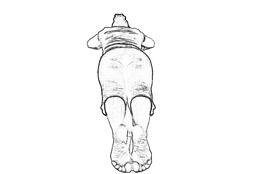

-
Lie on your stomach with your legs straight.
-
Contract and squeeze your buttocks (or you can do one at a time).
-
Allow your knee caps to turn outward.
-
In a controlled manner, slowly relax and repeat.
-
Hold for 5-10 seconds
Prone Hip Extension
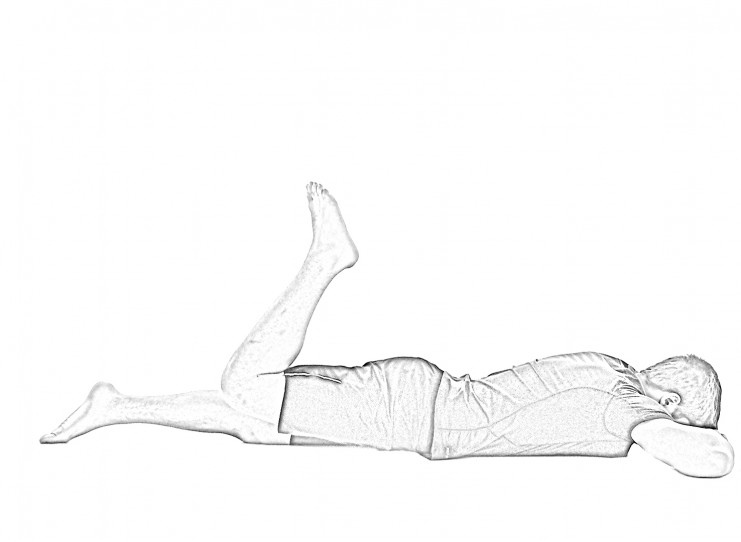

-
Lie face down while bending one knee.
-
Tighten your abdominals to keep the spine and pelvis neutral.
-
Contract your buttocks to lift the bent leg off the ground without moving the pelvis.
-
Hold for 5-10 seconds and slowly release and lower.
-
Repeat on the other side.
-
You can place a pillow under your hips for comfort.
Isometric Hip Extension

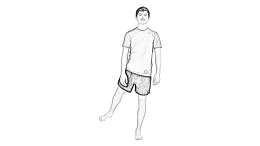
-
Stand on one leg, extend and externally rotate slightly the leg that is unsupported.
-
Keep your balance and do not allow any movement at the trunk or pelvis.
-
Hold the position and slowly return to the starting position.
-
Repeat with the other leg.
Glute Bridge

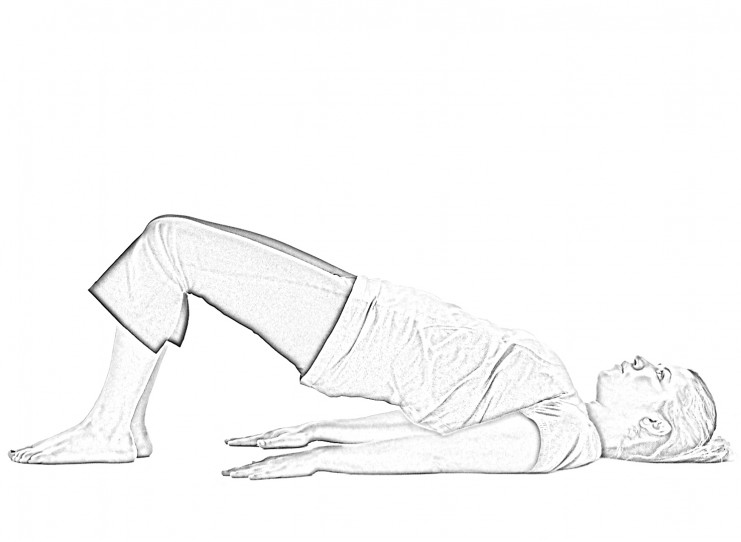
-
Lie on your back with your knees bent.
-
Squeeze your buttocks together and lift them off the ground to make a straight line with your body.
-
Slowly lower your body and repeat.
-
Your head, shoulders and feet are the points of contact on the ground in the high position.
-
Try holding for 5-10 sec at top position
Bilateral with ball


-
Bilateral with a ball or pillow (works adductors and gives extra support)
-
Lay down on your back with knees bent and a ball or pillow between them. Squeeze the ball and then
-
Squeeze the glutes and contract the abdominals to lift the hips off the ground. As you lift, squeeze the ball or pillow between the legs.
-
Hold for 5-10 seconds and slowly release as you lower.
Single Leg Bridge


-
Lie on your back with one knee bent, foot on the floor, and the other leg straight.
-
Contract your abdominal muscles and your buttocks while lifting your buttocks off the ground until your trunk is aligned with your supporting leg.
-
Hold for prescribed time (5-10 sec)
-
Lower your body slowly and repeat.
Clamshell


-
Lie on your side with both legs slightly bent and pelvis pointing slightly down towards the bed (rotate hips towards bed/floor)
-
Lift your top leg keeping your pelvis stable, your leg slightly bent and your heels together.
-
Make sure your hip does not rotate backwards
-
Hold for 5-10 seconds
-
Return to initial position and repeat.
-
Should feel it in the “back pocket” of your glutes – If you don’t, a quick fix is to ensure that your hips are rotated towards the bed/floor and are not moving throughout the exercise
-
If it begins to feel too easy, you can add a theraband around your knees or try the side step exercise
Side Steps

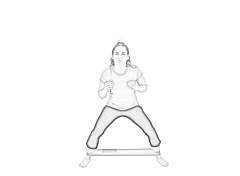
-
Start in a squat position with a band around your lower leg (above ankle).
-
Keeping the band stretched at all times, step to the side.
-
Push the knees out while taking the steps so they don’t cave in.
-
While stepping to the side, make sure that your hips stay at the same level (no bobbing up and down)
-
Each step is about 50% of the starting position stance.
NOTE:
-
In a study it has been shown that having the band placed around the ankle or the foot instead of the knee increases activation of the gluteus medius ~ 25% and ~ 40%, respectively. It also increases activation of gluteus maximus 60% and ~ 40%, respectively.
Squats
Partial Squat


-
Stand in front of a stable chair or countertop and hold onto it, if necessary
-
Pretend that you are going to sit in a chair – Stick your butt backwards
-
While maintaining your back straight and your hips above the level of your knees, slowly lower your body into a semi-squat position without leaning forward and keeping your heels in contact with the ground at all times.
-
Knees should not go past your toes.
Wall Squat W/ Ball

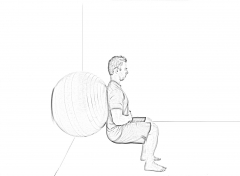
-
Place a ball between your back and the wall with your feet shoulder width apart and facing forward.
-
For more knee stability, you can place a small ball between knees.
-
Slowly bend your knees to 90 degrees keeping knee caps in line with 2nd toe (toe beside big toe), whilst squeezing ball between knees.
-
Don’t let your knees go further than your toes.
-
Slowly return to standing position and repeat.
NOTE:
-
Maintain proper low back posture (slightly arched) and stability of the knees (avoid any lateral movements).
Benefits
Using these exercises will help you focus on activating the glutes, which is key to building the muscle. Sometimes the muscles can become fatigued and/or weak.
With exercises that focus on using the glute muscles, your body can begin to utilize them properly.
This is an important step as it builds a strong foundation for your muscles to grow on.
The result will be an improved ability to perform complex movements and/or movements with weights.
Injury Prevention
Be sure to begin your exercises with a warm-up prior to a leg workout or by themselves.
Do all exercises within pain limits.
If the exercises begin to hurt, either decrease the amount of sets and/or reps you do or change the exercise.
Be sure that you are targeting other muscles, such as the gluteus medius which can become weak.
Ensuring your exercises are activating the various glute muscles is very important.
If you are having issues reaching your goals alway consult a professional such as a physiotherapist for help with an injury.
Final Thoughts
Pain and dysfunction in our movement are two things we would like to avoid if possible.
Sometimes, especially living an active lifestyle or being an athlete.
Injury can take us away from the activities we enjoy doing and can be difficult to fix.
But by doing exercises that focus on the muscle group can help strengthen weak/fatigued muscles.
Allow you to engage your glutes properly and build a foundation making them stronger over time.
There are many different exercises that focus on your glutes outside of the sample list of exercises we have provided, but it’s a great place to start.
To ensure proper form or to get further advice/assistance with exercises get in touch with your local physiotherapist professional.
Also, balance is a huge factor in improving strength – read more about proprioception better understand how balance exercises can aide in making you stronger.
-
Progressive hip rehabilitation: The effects of resistance band placement on gluteal activation during two common exercises
-
Edward D.J. Cambridge ⁎, Natalie Sidorkewicz, Dianne M. Ikeda, Stuart M. McGill Department of Kinesiology, University of Waterloo, Waterloo, Ontario, Canada
-
Clinical Biomechanics, 2012-08-01, Volume 27, Issue 7, Pages 719-724, Copyright © 2012 Elsevier Ltd
Need more stretching exercises? Select a chapter below:
Don’t miss out!
Subscribe to our newsletter to get your free copy of our stretching guide and get notifications when we make a new post to help you reach your fitness goals.